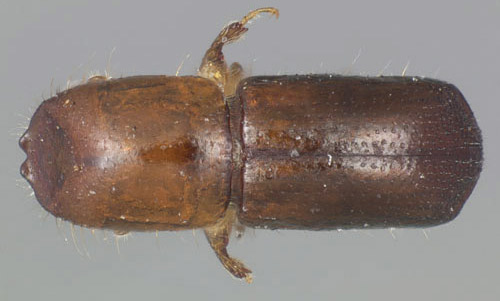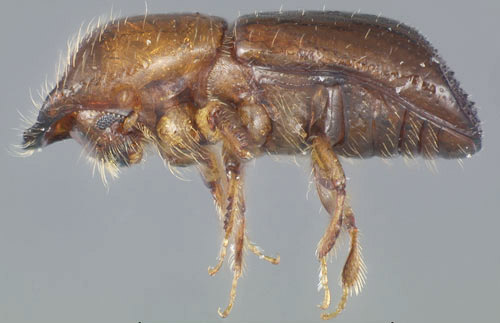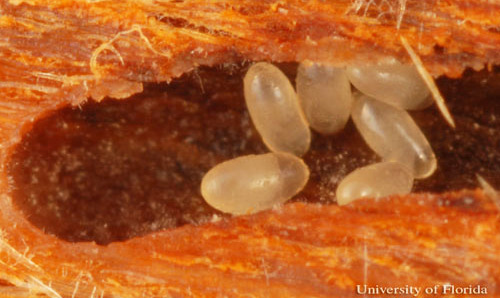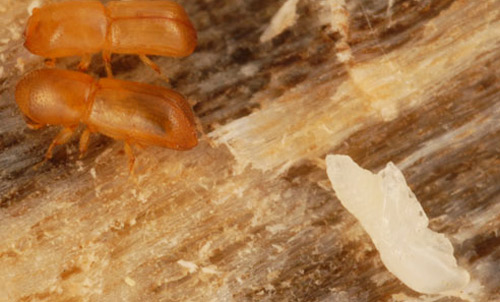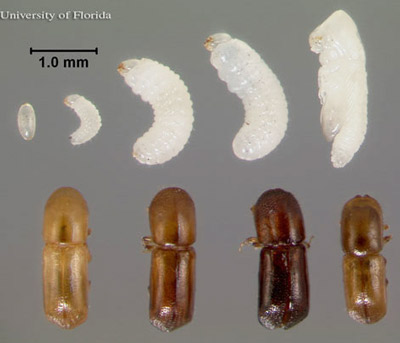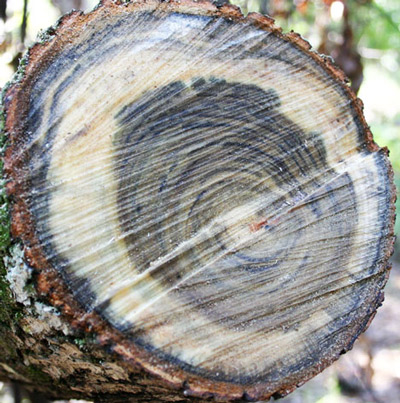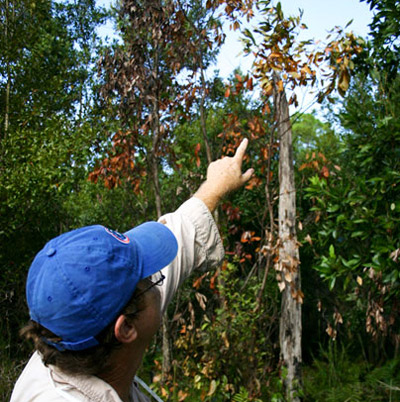common name: redbay ambrosia beetle
scientific name: Xyleborus glabratus Eichhoff (Insecta: Coleoptera: Curculionidae: Scolytinae)
Introduction - Distribution - Description - Biology - Hosts - Damage and Symptoms - Spread - Management - Selected References
Introduction (Back to Top)
Ambrosia beetles are wood-degrading insects which live in nutritional symbiosis with ambrosia fungi. Typically, ambrosia beetles are considered beneficial because they accelerate the decay of dead trees, which is important for nutrient cycling in healthy forests. The redbay ambrosia beetle, Xyleborus glabratus Eichhoff and its fungal symbiont, Raffaelea sp., are new introductions into the southeastern United States. Xyleborus glabratus was first detected in 2002 and is one of the 10 ambrosia beetle species in the U.S. (Haack 2003, 2006). The beetle transmits the causal pathogen of laurel wilt disease among plants in the Laurel family (Lauraceae), which is caused by one of its fungal symbionts, Raffaelea lauricola (Mayfield and Thomas 2006, Fraedrich et al. 2009). The Xyleborus glabratus and Raffaelea lauricola complex is considered a very high risk invasive disease pest complex having potential equal to that of Dutch elm disease or chestnut blight (Global Invasive Species Database 2010). Laurel wilt is a relatively new disease and much is still unknown about how it will impact the flora of North America.
Distribution (Back to Top)
Xyleborus glabratus is native to India, Japan, Myanmar and Taiwan (Rabaglia 2008). In the U.S., Xyleborus glabratus was first detected in a survey trap near Port Wentworth, Georgia in 2002 (Rabaglia 2008). In Florida, Xleborus glabratus was first detected in 2005 at the Timucuan Ecological and Historic Preserve in northern Duval County (Mayfield and Thomas 2006). Currently, the redbay ambrosia beetle is an economically important pest in Florida, Georgia and South Carolina. Recently, the beetle was detected in Jackson County, Mississippi (Riggins et al. 2010); Mobile County, Alabama (Alabama forestry commission 2010); and Bladen County, North Carolina (R. Trickel unpublished results). The pest continues to expand rapidly to new areas posing a threat to redbay and avocado trees in the U.S. and in the countries of Central and South America.
Description (Back to Top)
Adult: The adult Xleborus glabratus is a small, elongate, cylindrical beetle about 2 mm in length. It is very similar in appearance to other ambrosia beetles (both native and exotic) already found in the U.S. The combination of its blackish coloration, nearly glabrous upper surface, V-shaped and pointed abdominal tip, and abrupt apical declivity distinguishes this species from other ambrosia beetles occurring in Florida (Mayfield and Thomas 2006). However, expert examination by a specialist is needed for positive identification and confirmation. Males are dwarfed, haploid, flightless, and rarely encountered (Rabaglia 2008).
Figure 1. Dorsal view of an adult female redbay ambrosia beetle, Xyleborus glabratus Eichhoff. Photograph by Lyle J. Buss, University of Florida.
Figure 2. Lateral view of an adult female redbay ambrosia beetle, Xyleborus glabratus Eichhoff. Photograph by Lyle J. Buss, University of Florida.
Figure 3. Dorsal view of an adult male redbay ambrosia beetle, Xyleborus glabratus Eichhoff. Photograph by Lyle J. Buss, University of Florida.
Figure 4. Lateral view of an adult male redbay ambrosia beetle, Xyleborus glabratus Eichhoff. Photograph by Lyle J. Buss, University of Florida.
Egg:
Figure 5. Eggs of the redbay ambrosia beetle, Xyleborus glabratus Eichhoff, inside gallery which an adult female constructed. Photograph by Lyle J. Buss, University of Florida.
Larva: The larva of Xyleborus glabratus is similar to other scolytid beetles. It is a white, c-shaped, legless grub with an amber-colored head capsule (Rabaglia 2008).
Figure 6. Larvae of the redbay ambrosia beetle, Xyleborus glabratus Eichhoff, inside galleries which adult females constructed. Photograph by Lyle J. Buss, University of Florida.
Pupa:
Figure 7. Two newly emerged (exoskeleton still darkening) adult redbay ambrosia beetles, Xyleborus glabratus Eichhoff, near a white pupa (bottom right) from which the adult has not yet emerged. Photograph by Lyle J. Buss, University of Florida.
Biology (Back to Top)
Currently, very little is known about the life cycle and biology of Xleborus glabratus. However, it is presumed that its biology is similar to that of other species in the Xyleborini (Mayfield and Thomas 2006). Adult females bore into the wood just below the bark and construct galleries in the sapwood, inoculating the galleries with a fungus (Rabaglia 2008, Mayfield and Thomas 2006). Most of the life cycle including mating, egg laying and larval development is completed within these galleries. The adults and larvae feed on fungi and not on the wood of the damaged host plant (Rabaglia 2008). Adults are active throughout the year with peak activity in early September (Hanula et al. 2008). In Asia, the beetle has been reported to survive in temperatures ranging from -26 to 15°C. The flight activity is greatest late afternoon or early evening and the beetles usually fly at or below 15 ft (G. Brar unpublished results).
Figure 8. Life cycle of the redbay ambrosia beetle, Xyleborus glabratus Eichhoff. Top row, left to right: egg; 1st, 2nd and 3rd instar larvae, pupa. Bottom row, left to right: the first three adults are females with progressively darkening exoskeltons, the final adult is a male. Photograph by Lyle J. Buss, University of Florida.
Most native ambrosia beetles attack only dead and dying trees. However, Xleborus glabratus initiates attacks on healthy redbay trees. The beetles drill through the bark and inoculate tree xylem with their symbiotic fungi, Raffaelea lauricola. The beetle carries the fungus in mandibular mycangia (specialized sacs above mandibles adapted for fungus transport). After becoming infected, redbays wilt within weeks to a few months. The dying tree is also colonized by numerous other ambrosia beetle species, including Xleborus affinis, Xleborus ferrugineus, Xyleborinus saxeseni and Xylosandrus crassiusculus which further inoculate the tree with their associated fungi (J. Foltz unpublished results). Beetles reproduce within their galleries and newly emerging females fly in search of new hosts. In the southeast, there could be multiple overlapping generations per year (Global Invasive Species Database 2010). The brood development occurs within 50–60 days (Hanula et al. 2008, G. Brar unpublished results).
Both haplo-diploidy and inbreeding is common in ambrosia beetles including Xleborus glabratus. Females lay both diploid and haploid eggs. The more prevalent diploid eggs develop into females whereas males hatch from unfertilized haploids eggs. Therefore, males are haploid and flightless clones of their mothers with 50% of her genetic material. The males spend most of their life inside the natal gallery fertilizing their own sisters. Such sons allow single females to establish successful populations in non-native locations (Kirkendall 1983).
Hosts (Back to Top)
The host range of Xleborus glabratus includes plants in the Dipterocarpaceae, Fagaceae, Fabaceae and Lauraceae families in Southeast Asia (Rabaglia et al. 2006).
The complete host range of Xleborus glabraus in the U.S. is unknown. However, all investigated American members of the Lauraceae family have been found susceptible to the disease (Ploetz and Peña 2007). The hosts of Xleborus glabartus and laurel wilt in the U.S. include:
- avocado, Persea americana
- California bay laurel, Umbellularia californica
- northern spicebush, Lindera benzoin
- redbay, Persea borbonia
- sassafras, Sassafras albidum
- swampbay, Persea palustris
(Rabaglia et al. 2006, Smith et al. 2009)
The laurel wilt fungus has also been found on two critically endangered shrubs in Florida:
- pondberry, Lindera melissifolia
- pondspice, Litsea aestivalis
(Fraedrich et al. 2007)
The beetle also feeds on camphor tree, Cinnamomum camphora, which is listed as a Category I invasive species by the Florida Exotic Pest Plant Council. However, the camphor tree is not on the Federal or State noxious weed list (Florida Exotic Pest Plant Council 2011).
Damage and Symptoms (Back to Top)
Xyleborus glabratus is the only known vector of Raffaelea lauricola (Crane et al. 2008, Fraedrich et al. 2008). Trees attacked by Xleborus glabratus exhibit few external symptoms initially. Small strings of compacted sawdust protrude from the bark at the point of attack; however, these strings disintegrate easily and are not always readily apparent. Removal of bark at the point of attack reveals shot-holes from which a dark stain extends into the surrounding xylem. Initial attacks introduce spores of the fungus into the xylem of the host tree. The fungal infection is visible by stained sapwood upon removal of bark or in cross sections of the stem. The stain is the tree's response to fungal infection which gradually spreads through the outer sapwood.
Figure 9. Small strings of compacted sawdust, protruding from the bark at the point of attack, are an indication of an infestation by the redbay ambrosia beetle, Xyleborus glabratus Eichhoff. Photograph by Michael Flores, University of Florida.
Figure 10. Stained sapwood is an indication of an infestation by the redbay ambrosia beetle, Xyleborus glabratus Eichhoff. Photograph by Michael Flores, University of Florida.
Trees infested with laurel wilt are characterized by a dark discoloration in the outer sapwood. Affected trees exhibit wilted foliage with a reddish or purplish discoloration. Foliar discoloration may occur within a section of the crown or the entire crown. The foliage eventually turns brown and tends to remain on the branches (Fraedrich et al. 2008). In redbay, the fungus moves rapidly through the xylem, plugging the flow of water and causing the trees to die within few weeks or months.
Figure 11. Wilted foliage, with a reddish or purplish discoloration, caused by an infestation of the redbay ambrosia beetle, Xyleborus glabratus Eichhoff. Photograph by Michael Flores, University of Florida.
Spread (Back to Top)
Xleborus glabratus is presumed to have been introduced into the U.S. through solid wood packing materials (Fraedrich et al. 2007). The cryptic nature of ambrosia beetles makes them difficult to detect in shipments of trees or wood products (Oliver and Mannion 2001, Rabaglia et al. 2006, Koch and Smith 2008). Local spread of beetles is potentially caused by the transport of fuel wood, tree trimmings, and other infested wood products (Rabaglia 2008). Barbecue smoke-wood may also serve as a potential vehicle for moving the beetle and the fungus into new areas. The natural rate of movement of the Xleborus glabratus-laurel wilt complex within forests is estimated up to 34 miles per year (Koch and Smith, 2008). The actual spread could be even faster, especially when aided by human transport. The beetle is attracted to volatiles naturally emitted by living trees, severed limbs, tree stumps, and pruned trees of avocado, Persea americana, and redbay, Persea borbonia (Hanula et al. 2008). Female beetles are believed to be capable of flying 2–3 km in search of a host (Rabaglia 2008).
Management (Back to Top)
Currently, there are no methods for preventing further infestation of susceptible trees where redbay ambrosia beetle is established. In Florida trees with signs of rapid wilting, dieback, and insect boring in redbay and other host trees should be reported to the Florida Department of Agriculture and Consumer Services' Division of Plant Industry or Division of Forestry.
To avoid spreading the beetle and pathogen to new areas, redbay and other hosts of redbay ambrosia beetle should not be moved or sold as firewood, tree trimmings, or barbecue smoke-wood. Wood from infested trees should not be transported out of the local area where the infested trees are detected. Dead redbay or other Lauraceous tree species cut in residential areas should be chipped and left onsite as mulch, or disposed of as locally as possible. The pathogen does not survive in the mulched wood chips (Crane et al. 2011).
Manuka oil, the essential oil extracted from Leptosperum scoparium and Phoebe oil, an extract of Brazilian walnut (Phoebe porosa) are potent attractants of Xleborus glabratus. Both oils are effective baits for monitoring Xleborus glabratus populations (Hanula and Sullivan 2008).
Chemical control of X. glabratus through aerial sprays is complicated and impractical because adult beetles must be in the immediate area that is treated. Once adult beetles bore into trees, contact insecticides are ineffective. For management of the vector and pathogen in avocado groves, growers should maintain tree health by preventing plant stress caused by abiotic and biotic factors. Ambrosia beetles are known to attack trees suffering from some type of environmental or cultural stress (drought, flooding, freezing, nutrient deficiencies, etc.). Avocado trees with confirmed disease symptoms should be removed to prevent spread of the vector and pathogen (Cameron et al. 2008, Hanula et al. 2008). The infested wood should be burnt within the infested grove without transportation (Crane, 2009). Avocado trees not showing symptoms but present adjacent to trees with confirmed symptoms of disease may be treated with contact insecticides to kill flying beetles (Crane et al. 2011). Damaged or pruned avocado wood is more attractive to X. glabratus than non-damaged wood for up to three weeks. Therefore, groves should be pruned during the late fall or winter when X. glabratus activity is low. Groves should be pruned early in the morning and the cut surfaces should be treated with contact insecticides with residual activity (Crane et al. 2011).
Selected References (Back to Top)
- Alabama Forestry Commission. (November 2010). Redbay ambrosia beetle. http://www.forestry.state.al.us/RedbayAmbrosiaBeetle.aspx (no longer online).
- Cameron, RS, Bates C, Johnson J. (September 2008). Distribution and spread of laurel wilt disease in Georgia: 2006–08 survey and field observations. Georgia Forestry Commission. U.S. Forest Service. http://fhm.fs.fed.us/em/funded/09/so-em-08-02-report.pdf (29 April 2019).
- Crane JH. (March 2009). Issues concerning the control of the redbay ambrosia beetle (Xyleborus glabratus) and spread of the laurel wilt pathogen (Raffaelea lauricola). Avocadosource.com. http://www.avocadosource.com/papers/Research_Articles/CraneJonathan2009.pdf (29 April 2019).
- Florida Exotic Pest Plant Council. (2011). Florida EPPC's 2009 Invasive Plant Species List. https://www.fleppc.org/list/list.htm (29 April 2019).
- Fraedrich SW, Harrington TC, Rabaglia RJ. (2007). Laurel wilt: a new and devastating disease of redbay caused by a fungal symbiont of the exotic redbay ambrosia beetle. Newsletter of the Michigan Entomological Society 52: 15-16.
- Fraedrich SW, Harrington TC, Rabaglia RJ, Mayfield AE, Hanula JL, Eickwort JM, Miller DR. 2008. A fungal symbiont of the redbay ambrosia beetle causes a lethal wilt in redbay and other Lauraceae in the Southeastern United States. Plant Disease 92: 215-224.
- Global Invasive Species Database. (May 2010). Xyleborus glabratus (insect). http://www.issg.org/database/species/ecology.asp?si=1536&fr=1&sts=&lang=EN (29 April 2019).
- Haack RA. 2003. Intercepted Scolytidae (Coleoptera) at U.S. ports of entry: 1985-2000. Integrated Pest Management Reviews 6: 253-282.
- Haack RA. 2006. Exotic bark- and wood-boring Coleoptera in the United States: recent establishments and interceptions. Canadian Journal of Forest Research 36: 269-288.
- Hanula JL, Mayfield AE, Fraedrich SW, Rabaglia RJ. 2008. Biology and host associations of redbay ambrosia beetle (Coleoptera: Curculionidae: Scolytinae), exotic vector of laurel wilt killing redbay trees in the southeastern United States. Journal of Economic Entomology 101: 1276-1286.
- Hanula JL, Sullivan B. 2008. Manuka oil and phoebe oil are attractive baits for Xyleborus glabratus (Coleoptera: Scolytinae), the vector of laurel wilt. Environmental Entomology 37: 1403-1409.
- Kirkendall LR. 1983. The evolution of mating systems in bark and ambrosia beetles (Coleoptera: Scolytidae and Platypodidae). Zoological Journal of the Linnean Society 77: 293-352.
- Koch FH, Smith WD. 2008. Spatio-temporal analysis of Xyleborus glabratus (Coleoptera: Circulionidae: Scolytinae) invasion in eastern US forests. Environmental Entomology 37: 442-452.
- Oliver JB, Mannion CM. 2001. Ambrosia beetle (Coleoptera: Scolytidae) species attacking chestnut and captured in ethanol-baited traps in middle Tennessee. Environmental Entomology 30: 909-918.
- Ploetz RC, Peña JE. (2007). Laurel wilt: a lethal disease on avocado and other Lauraceous hosts. Caribbeanseeds.com. http://www.caribbeanseeds.com/Laurel-wilt-overview.pdf (no longer online).
- Rabaglia RJ, Dole SA, Cognat AI. 2006. Review of American Xyleborina (Coleoptera : Curculionidae : Scolytinae) occurring North of Mexico, with an illustrated key. Annals of the Entomological Society of America 99: 1034-1056.
- Riggins JJ, Smith JA, Mayfield AE, Layton B, Balbalian C, Campbell R. 2010. First occurrence of laurel wilt disease on redbay trees in Mississippi Plant Disease 94: 634.
- Smith JA, Mount L, Mayfield AE, Bates CA, Lamborn WA, Fraedrich SW. 2009. First report of laurel wilt disease caused by Raffaelea lauricola on camphor in Florida and Georgia. Plant Disease 93:198.


